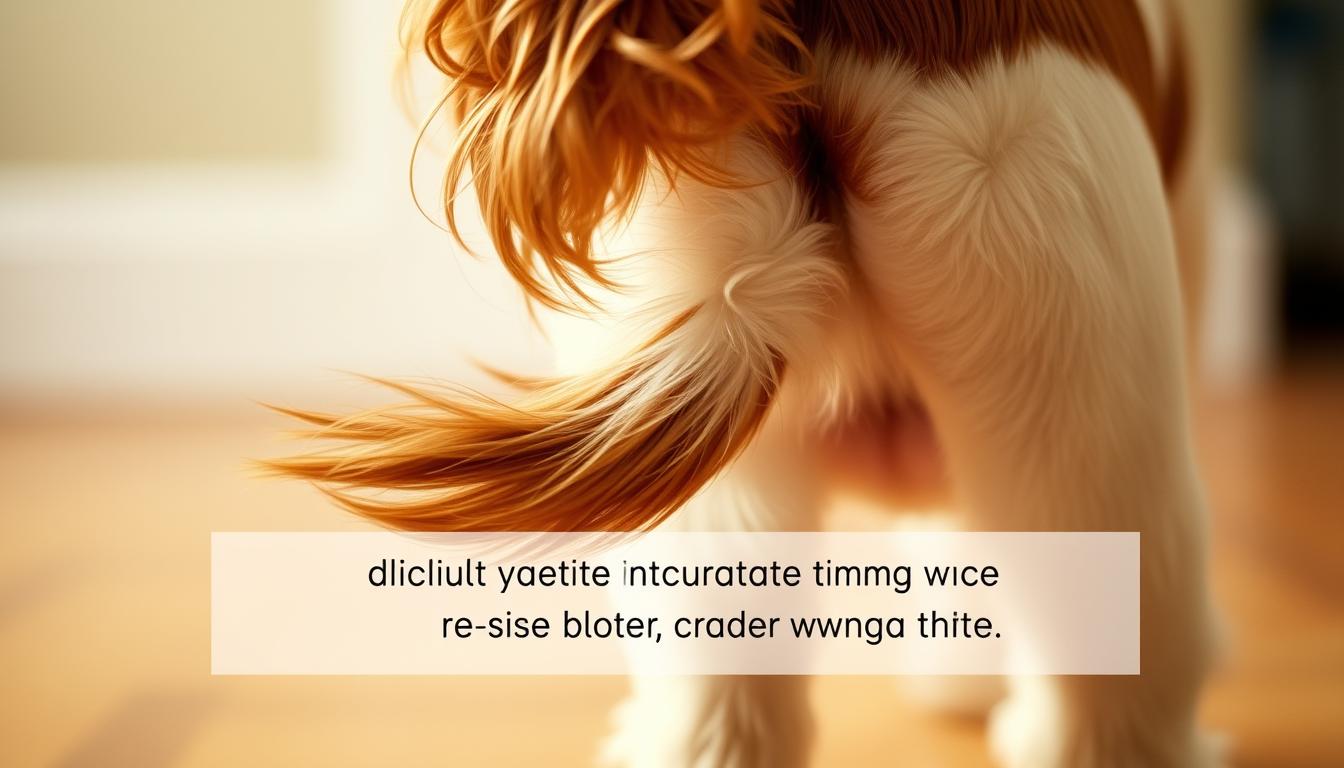Many pet owners associate vigorous tail movements with their furry friend’s joy. While this is often true, excessive motion can sometimes signal hidden health risks. One such concern is a condition where enthusiastic wagging leads to injury – particularly in breeds with long, slender tails.
This issue occurs when repeated contact with hard surfaces damages the tip of the tail. Over time, the skin may crack or bleed, creating openings for infections. Despite its cheerful nickname, the situation causes discomfort and requires prompt attention from vets.
Understanding your pet’s body language goes beyond interpreting moods. Observing patterns helps distinguish between healthy expressions and potential harm. Breeds prone to this injury often need extra protection during play or excitement.
Key Takeaways
- Over-enthusiastic tail movements can lead to physical harm in some breeds
- Injuries often start as minor abrasions but may develop serious complications
- Regular checks of your pet’s tail help catch issues early
- Soft padding around home surfaces reduces collision risks
- Consult a vet if you notice persistent swelling or unusual behaviour
Understanding Happy Tail Syndrome in Dogs
While tails often express canine joy, excessive movement can mask hidden risks. Happy tail syndrome describes a painful condition where repeated collisions with hard surfaces damage the tail’s tip. Despite its cheerful name, this syndrome creates open wounds that struggle to heal due to constant motion.
Definition and Overview
This syndrome occurs when dogs repeatedly strike their tails against walls, furniture or kennel surfaces. The tail’s thin skin splits easily, particularly in breeds with long, bony appendages. Boarding facilities and confined spaces heighten risks due to limited movement areas.
How Tail Injuries Occur
Three factors combine to create trauma:
- Powerful wagging force
- Hard surface impacts
- Minimal protective fur on tail tips
Injuries begin as minor scrapes but worsen with each collision. Blood vessels near the skin’s surface rupture easily, leading to bleeding that attracts licking and infection. The table below shows breed vulnerabilities:
| High-Risk Breeds | Low-Risk Breeds |
|---|---|
| Thin tails with short fur | Curled or thickly furred tails |
| Large, energetic breeds | Smaller, calmer breeds |
| Working dogs in confined spaces | Pets in open living areas |
Healing proves difficult because tails remain in motion during recovery. Protective measures become essential once injury patterns emerge.
Cocker Spaniel Happy Tail Wagging: A Window into Your Pet’s Emotions
A dog’s tail serves as an emotional barometer, offering insights into their inner world. While these expressive motions often signal joy, they can also reveal anxiety, curiosity, or discomfort. Learning to decode these signals strengthens the bond between owners and their pets.

Interpreting Tail Movements
Position and motion patterns reveal distinct moods. A relaxed, sweeping motion at mid-height typically indicates contentment. Rapid vibrations at high angles often signal heightened alertness, while low, slow movements may suggest uncertainty.
Consider these common signals:
- Horizontal position with stiff movements: Focused attention
- Tucked tightly under body: Anxiety or fear
- Circular motions during play: Exuberant excitement
When Behaviour Warrants Concern
Persistent, forceful motions against hard surfaces demand attention. Obsessive wagging that continues despite visible discomfort suggests potential neurological factors. Owners should monitor for:
- Repeated impacts during normal activities
- Reluctance to settle despite exhaustion
- Guarding behaviour around the tail area
Veterinary behaviourists note: “Canine body language requires holistic interpretation – never assess tail motions in isolation.” Pair observations with ear position, vocalisations, and overall posture for accurate emotional assessments.
Recognising the Signs and Symptoms
Early detection of canine tail injuries relies on spotting subtle physical changes. Owners often first notice clues in their home environment rather than directly on their pet. Regular checks during grooming sessions help identify issues before they escalate.

Visible Indicators: Bleeding, Hair Loss and Cracking
Initial symptoms appear gradually. Look for these changes at the tail tip:
- Patchy hair loss revealing pinkish skin
- Minor scratches resembling paper cuts
- Dry, flaky skin with visible cracks
As damage progresses, intermittent bleeding leaves telltale red speckles on light-coloured walls or bedding. The table below shows symptom progression:
| Early Stage | Advanced Stage |
|---|---|
| 1-2mm skin splits | 5mm+ open wounds |
| Occasional blood spots | Persistent staining |
| Localised hair thinning | Bald patches |
Other Warning Signals
Watch for unusual patterns during daily activities. Dogs may repeatedly circle before lying down or avoid tail contact with favourite resting spots. A Brisbane vet notes: “Many cases present with blood spatter on crate ceilings – an indicator of forceful upward motions.”
Differentiate from flea bites or allergies by checking:
- Injury location (always tip-focused)
- Lack of body-wide irritation
- Normal energy levels despite visible damage
Causes and Risk Factors for Tail Injuries
Tail injuries often stem from interactions between a pet’s physical traits and their surroundings. Environmental hazards combine with genetic predispositions to create perfect conditions for repetitive trauma. Understanding these factors helps owners modify spaces and routines effectively.
Environmental Triggers and Hard Surfaces
Daily activities in modern homes expose dogs to multiple collision risks. Common trouble spots include:
- Low coffee tables with sharp edges
- Narrow hallways between rooms
- Concrete fencing in outdoor areas
Boarding facilities and travel crates amplify dangers due to restricted movement. A 2022 Australian veterinary study found 68% of syndrome dogs developed injuries during kennel stays. Hard surfaces like tiles or wooden walls increase impact force during enthusiastic movements.
Breed-Specific Vulnerabilities
Physical characteristics make some dogs more prone to tail syndrome. Breeds with these traits face higher risks:
| High-Risk Features | Low-Risk Features |
|---|---|
| Long, whip-like tails | Short, curled appendages |
| Thin fur coverage | Thick protective coats |
| High-energy temperament | Calm disposition |
Working breeds and large dogs account for 82% of cases in emergency clinics. Their combination of powerful wagging force and minimal tail padding leads to frequent damage.
Treatment and Management Options
Addressing persistent tail injuries requires professional guidance and patience. Vets typically combine immediate treatment with long-term strategies to protect sensitive areas. The goal is to break the cycle of damage while maintaining the pet’s quality of life.
Veterinary Interventions and Medical Treatments
Initial care focuses on wound cleaning and infection prevention. A veterinarian may apply medicated wraps using breathable materials that cushion impacts. Common prescriptions include:
- Pain medication to ease discomfort
- Antibiotics for existing infections
- Mild sedatives to reduce movement
Nutritional supplements like Omega-3 oils may also improve skin elasticity. One Sydney clinic reports: “Patients using vitamin E ointments show 40% faster healing times compared to standard care.”
Bandaging, Tail Slings and Medications
Proper bandaging techniques prevent circulation issues while protecting injuries. Specialised devices like tail slings immobilise the area without restricting movement entirely. Consider these options:
| Short-Term Solutions | Long-Term Management |
|---|---|
| Foam-padded wraps | Custom protective sleeves |
| Elizabethan collars | Tail suspension harnesses |
| Daily antiseptic rinses | Moisturising barrier creams |
When conservative methods fail, surgical amputation becomes necessary. This procedure removes damaged tissue while preserving the tail’s base. Most pets adapt within weeks, though healing time varies by age and health status.
Preventative Measures for a Healthy Tail
Tail injuries can often be prevented with thoughtful changes to your home layout. Start by identifying high-risk zones where enthusiastic movements collide with hard surfaces. A thorough safety audit helps spot hazards like sharp table edges or narrow walkways.
Home Safety Adjustments
Modify living spaces to cushion impacts. Cover wooden furniture legs with foam tubing from hardware stores. Create clear pathways by rearranging obstacles that restrict natural movement patterns.
Consider these protective upgrades:
| DIY Solutions | Professional Options |
|---|---|
| Pipe insulation on edges | Custom silicone corner guards |
| Pool noodle barriers | Impact-resistant wall panels |
| Blanket-draped surfaces | Veterinary-approved crate padding |
Tail Protection Devices and Alternatives
Specialised gear shields vulnerable areas during active periods. Breathable neoprene sleeves allow movement while absorbing shock. For temporary use, modified baby socks secured with vet wrap work well.
Compare protection methods:
| Short-Term Fixes | Long-Term Solutions |
|---|---|
| Toilet roll splints | Adjustable silicone caps |
| Fabric tail slings | Medical-grade polymer guards |
| Adhesive bandages | Moisture-wicking compression wraps |
Regularly inspect the tail tip for early signs of skin damage. Rotate protective devices to prevent moisture buildup that could lead to infection. A Melbourne vet advises: “Combine environmental changes with positive reinforcement training for lasting results.”
Conclusion
Managing canine tail health requires a blend of vigilance and understanding. While enthusiastic movements express joy, repeated impacts can lead to chronic injuries needing professional care. Early detection remains crucial – minor changes in behaviour or physical appearance often hint at developing issues.
For severe cases, surgical solutions like partial amputation prove effective. Most pets recover within weeks, adapting quickly to modified appendages. As one Gold Coast vet notes: “Dogs focus on living, not dwelling on what’s missing – their resilience astonishes owners.”
Simple home modifications paired with professional guidance often prevent severe outcomes. Protective gear and padded surfaces reduce collision risks without stifling natural communication. Regular checks during grooming sessions help catch problems before they escalate.
Responsible ownership means balancing emotional expression with physical safety. Though syndrome management challenges some owners, modern veterinary options ensure good quality of life. With attentive care, pets continue sharing their vibrant personalities through body language – safely and sustainably.



